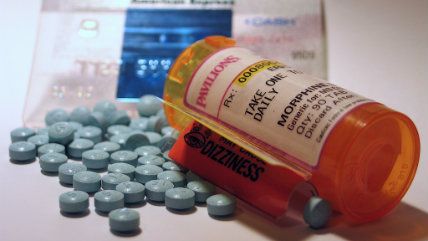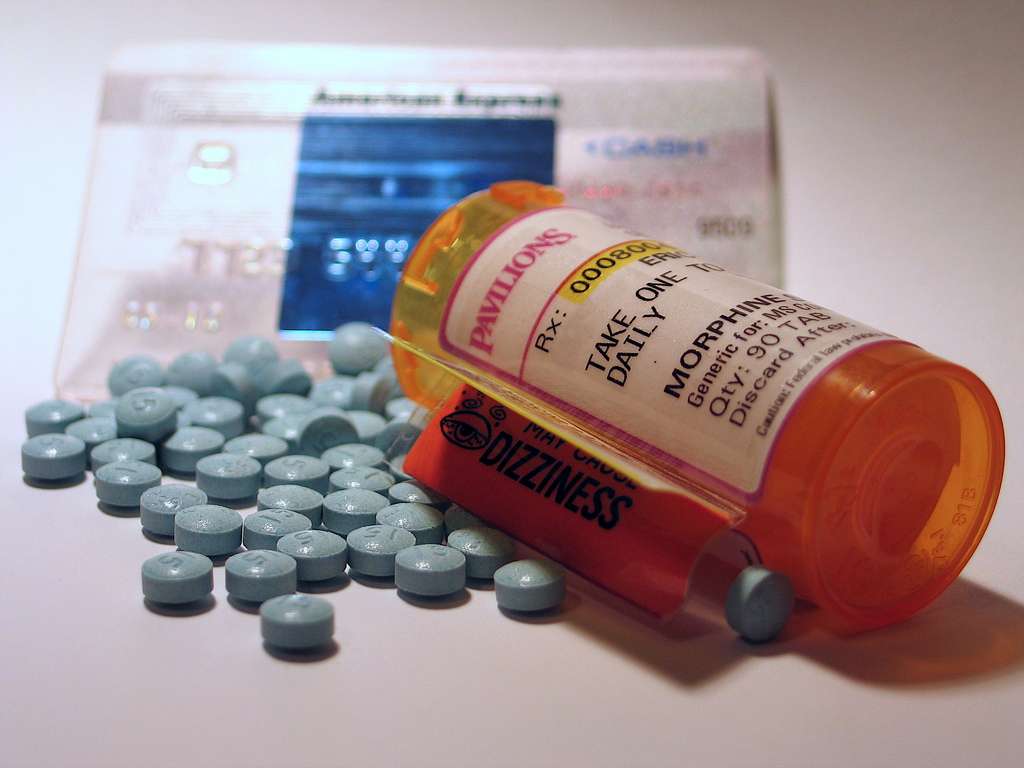Physicians Face Moral Dilemma In Conscription on War on Drugs
In the government's new war on opiates, physicians and their patients find themselves caught in the crossfire.


America's physicians have been conscripted as law enforcement agents in the never-ending War on Drugs, and it puts us in a moral dilemma.
As media attention has turned to the recent national surge in prescription-opioid and heroin abuse, politicians feel compelled to be ready with "solutions." The Obama Administration last summer announced $100 million in new funding for drug-addiction centers, and has recently announced new opioid training programs for federal government physicians. In a recent debate, Presidential candidate Hillary Clinton, exclaiming, "Lives are being lost," proposed a $10 billion criminal justice initiative including increased grants to states for drug treatment centers, as well as training and equipping first responders to administer heroin overdose antidotes. As a doctor, I react to these reports with great apprehension, because public policy will inevitably impact my profession and me.
Lessons From the First Drug War
With the passage of the Harrison Narcotics Act in 1914, opiates and cocaine for the first time were prohibited to the general public without a doctor's prescription. The Surgeon General reassured doctors that this was intended only as a means for the government to gather information. But when doctors began writing morphine prescriptions for patients (many of whom were affluent middle aged women at the time) as a means of helping them cope with their chronic addiction, they suddenly found themselves in violation of the fine print of the law: the doctor may prescribe "in the course of his professional practice only." This was interpreted by law enforcement to mean that these drugs could not be prescribed simply to help the patients avoid the pains of withdrawal from their addiction, and doctors risked indictment if they prescribed narcotics for this reason. The first War on Drugs was underway, and physicians found themselves caught in the crossfire.
Six weeks after the Harrison Narcotics Act's passage, the New York Medical Journal warned in an editorial that the new law will have ominous consequences, including "the failure of promising careers, the disrupting of happy families, the commission of crimes that will never be traced to their real cause, and the influx into hospitals for the mentally disordered of many who would otherwise live socially competent lives."
Critics of the War on Drugs like to use alcohol's prohibition and its subsequent re-legalization as a teaching tool for making their case. Alcohol is an extremely dangerous drug. Overdosing on alcohol can lead to coma and respiratory arrest. Long-term addiction can cause liver failure, gastrointestinal hemorrhage, cardiomyopathy and heart failure, pancreatitis, cancer of the stomach and esophagus, cognitive disorders, encephalopathy, and dementia. It didn't take long for the public to learn, however, that the destruction to society wrought by alcohol prohibition far outweighed the harmful effects of alcohol on the segment of society who could not use this drug in a safe and healthy way.
Fortunately, a doctor's prescription was never required for people to obtain alcohol. Such a requirement would have created a real moral dilemma for the physician: should he help the patient avoid the pains of alcohol withdrawal by writing the prescription? Is prescribing alcohol for that reason an appropriate one in the eyes of law enforcement? Furthermore, will prescribing the drug contribute to the patient's harm over the long term and thus violate professional ethics?
Opiates, by comparison, are much safer than alcohol. Long-term addiction can contribute to gastrointestinal motility and digestive problems, and research suggests it might slightly impair the immune system and promote mild hormonal dysfunction. Some studies have shown chronic use increases the risk of clinical depression, and might make users withdraw socially. There is no conclusive evidence that it can cause dementia or cognitive disorders. There is an honest disagreement among health care practitioners over just how harmful long-term opiate use can be.
So it would appear that prescribing opiates to an addict to help him avoid withdrawal would present less of a professional ethical dilemma than with alcohol. And the practitioner who doesn't feel it is ethical to subject the patient to the risks of long-term opiate use—even with the patient's informed consent—can always refer the patient to a doctor who doesn't see an ethical problem. Alas, that's not how things worked out.
Doctors began to cut their patients off from narcotics, fearing federal prosecution. Patients would "doctor shop," feigning painful illnesses, and when that didn't work, would turn to the streets to buy their opiates in the burgeoning illegal market. At first they purchased morphine on the street. But after heroin (diacetyl-morphine) was outlawed entirely in America in 1924 (it remains legal and is used in hospitals in Britain and other European countries under the name "diamorphine"), drug dealers pushed heroin over morphine. By the close of the 1920s, the great majority of opium addicts were now heroin addicts.
Opiophobia Onset | For More: See Reason's classic 1997 cover story No Relief in Sight
As the drug war intensified in the 1970s and onward, doctors became ever more leery of prescribing narcotics. And patients in pain became more fearful of taking them as they heard more horror stories about addiction. By the late 1990s, a new term was coined, opiophobia, to describe an irrational fear of opiate prescription and use by doctors and patients.
As professional and patient advocacy groups became more enlightened on the topic, however, patients were encouraged to overcome their fear of addiction, and doctors were exhorted to show more compassion and prescribe more liberally. By the dawn of the 21st century, narcotic prescription—and narcotic addiction—began to rise again.
In the past few years, a surge in opioid prescription use and opioid addiction has been noted with alarm by public health authorities. In response, the U.S. Drug Enforcement Administration (DEA) has partnered with state medical and pharmacy licensing boards and state health authorities in an effort to curb opioid prescription and root out "pill mill" practices.
Prescription Drug Monitoring Programs (PDMP) now track the prescribing patterns of health care practitioners as well as monitor the frequency and amounts of prescriptions filled by patients. Doctors are provided with periodic "report cards," comparing their prescribing patterns with their peers. In some states legislation is being considered to require prescribers to check on their patient through the PDMP before writing any opioid prescription. And law enforcement, often using undercover agents, have severely cracked down on providers they believe are over-prescribing.
This has chilled the behavior of many prescribers, who are beginning to revert to the old practice of cutting patients off.
History Repeating
According to the Centers for Disease Control and Prevention (CDC), heroin use in the U.S. has increased 63 percent over the past decade, while prescription-opioid abuse has also risen. In fact, 45 percent of heroin addicts are also prescription opioid addicts, the report claimed.
Addiction rates are up among both the affluent and people with health insurance. The CDC found that people in these groups tend to move on to heroin after being cut off from prescription opioids. (Sound familiar?)
Bree Watzak of the Texas A&M College of Pharmacy states in a 2015 report: "We see that people tend to move on to street drugs after they've lost access to prescription opioids. It's a progression."
Thomas Frieden, director of the CDC, said in a July 2015 interview with NPR that people who abuse prescription opioids are 40 times more likely to abuse or become dependent on heroin. He also lamented that heroin is more available than ever on the streets, and often far cheaper than prescription narcotics. In fact he estimates heroin to be one-fifth the cost of prescription drugs. This more than 50 years since President Nixon declared the second "War on Drugs."
So 102 years after the passage of the Harrison Narcotics Act, and 92 years after the banning of heroin in the U.S., here we are.
Short of ending the War on Drugs, there are steps that can be taken in the right direction. One is called "harm reduction." If a heroin addict is unwilling or unable to detox and undergo rehab, then at least provide clean needles with pharmaceutical grade heroin so as to avoid the spread of disease and enable the person to lead a more productive life. Programs like this in Switzerland, the U.K.,and other countries have been successful, and many addicts have been thus able to resume their occupations and a relatively conventional lifestyle. They no longer have to spend their days looking for the drug and they take just enough to be able to perform their jobs without experiencing withdrawal symptoms. Many, after returning to a conventional lifestyle, gradually taper themselves off the drug and voluntarily detox.
Another smart move would be to "decommission" doctors as agents of law enforcement. Allow doctors to prescribe opioids without fear of prosecution. A physician who encounters a patient with a dependency problem should have a frank discussion with that patient, inform the patient of the potential long-term health consequences of the addiction, and encourage treatment of the addiction. If the patient refuses treatment, then the physician can continue to write the opioid prescriptions in the interest of harm reduction—it certainly is preferable to patients going to the street for heroin and dirty needles.
It has been over a century since the government began its first War on Drugs. It set in motion a series of destructive unintended consequences affecting every one of us, and the medical profession has not been spared. We learned before that the harmful consequences of alcohol prohibition were worse than the drug itself. It's time we learn to apply that same insight to the other drugs, including narcotics.


Show Comments (88)